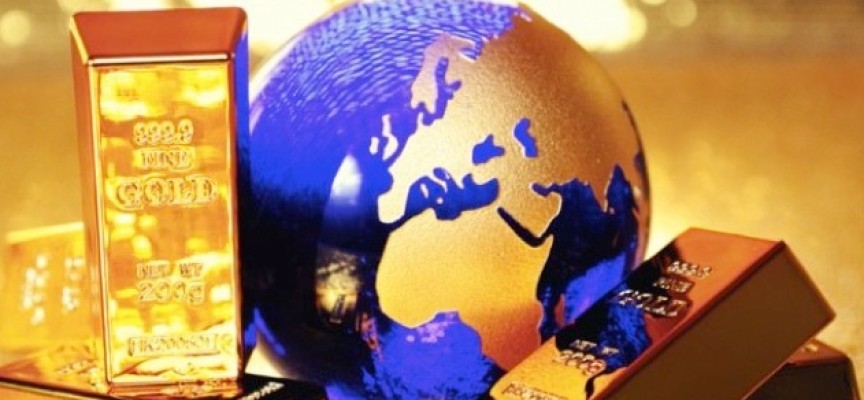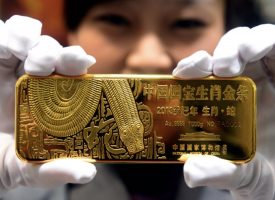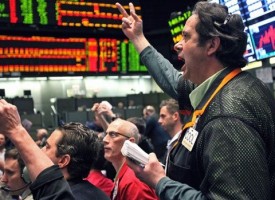Gold, silver and mining stocks surged today, but you haven’t seen anything yet according to one of the greats in the business.
Gold Gains 3.60%, Silver Climbs 6.14%
May 6 (King World News) – Paul Wong, Market Strategist at Sprott Asset Management: April provided precious metals markets redemption from a challenging first quarter, with gold finishing the month at $1,769.13 per ounce, rising 3.60%. Silver rose 6.14%, platinum climbed 1.34% and palladium gained 11.95%. Gold mining equities added 6.16%. For the twelve-month period ended April 30, 2021, gold climbed 4.90%, silver gained 73.13%, platinum rose 54.85%, palladium returned 49.25% and gold equities gained 0.77%.
Gold Rebounds from Oversold Levels
Spot gold gained $61.42 per ounce, or 3.60%, to close the month of April at $1,769.13. After the first quarter-end markdown, gold began to immediately recovery as bond yields fell quickly. Yields came in promptly as Japan’s selling of U.S. Treasury bonds ceased at quarter-end, and U.S. pensions and balanced funds bought bonds as they rebalanced their portfolios. This quick fall in yields forced some stops to lock in some profitable but extremely crowded bond shorts and bear steepener trades. Despite some huge beats on economic data points, yields in April were shrugging it off. In hindsight, many technical factors were exacerbating the move higher in yields in March. However, our Sprott Gold Bullion Sentiment Index confirmed the unusually oversold nature (-2 standard deviation readings) of both gold bullion and equities during March. From the oversold early March lows, gold equities rallied back up to the 200-day moving average before backing off. Silver continues to consolidate and base build within a bullish flag configuration.
Silver in Bullish Consolidation
Silver ended April at $25.92 per ounce, gaining $1.50 (6.14%) for the month. Growing investment and industrial demand continue to support higher silver prices and have created supply shortages. Silver continues to benefit from the expansionary monetary and fiscal policies worldwide and silver’s critical industrial role in the environmentally friendly technologies of the “green revolution.” Silver remains in a bullish consolidation in the form of flag or pennant formation (Figure 1). Typically, if these bullish flag formations hold together and break to the upside, the price objective can be significant. We will be prudent and wait for the pattern to be confirmed. The initial resistance will be $30, then $35 if the flag pattern is triggered.
Approaching Peak Macro
The question remains: How much of the stimulus and the post-COVID re-opening surge has been priced in by yields? Comparing today’s cycle to past market cycles, we are likely near the end of the “recovery phase.” The recovery phase typically favors economically sensitive sectors (i.e., cyclical, value) and massive risk-taking as central bank monetary stimulus (the tide that lifts all boats) makes its way through the financial system. We are likely near “peak macro.”
While U.S. economic growth is still greater than trend and consensus, the growth rate will peak soon as the stimulus cheques and re-opening tailwinds peak. The next part of the cycle will be the “expansion phase,” where bond-sensitive factors (i.e., inflation factors) begin to outperform the economy-sensitive factors. Market action becomes more nuanced as opposed to a simple tide that lifts all boats. As we approach peak macro, current market euphoria will become vulnerable again to cyclical disappointment. Though the U.S. is currently firing on all cylinders (Q1 2021 gross domestic product [GDP] of 6.4% annualized), the rest of the world is not. China has begun its slow down by limiting its credit growth to 2020 levels to prevent overheating its real estate market. The European Union is still struggling with its COVID vaccine rollout and has just posted another negative GDP quarter (Q1 2021 GDP of -0.6%). Parts of emerging markets, such as Brazil and especially India, are mired in terrible COVID crises. Potentially, sources of disappointment may be globally sourced…
To learn about one of the most exciting silver plays in
the world click here or on the image below

In this euphoric environment, the U.S. market is also pricing in a typical interest rate cycle, though the backdrop is vastly different from prior cycles. U.S. debt-to-GDP is about 130% (or 109% net of Treasury cash balances), near all-time highs back to World War II. Since the global financial crisis (GFC), debt has grown at about an 8.5% annualized rate while nominal GDP has annualized closer to 3.5%.
What is clear is that GDP growth cannot be sustained without massive stimulus. The U.S. is in a vicious cycle where it needs to run deficits to drive GDP growth, which creates larger deficits, and so on. The dual challenge will be how to have significant GDP growth without yields rising too much and how to avoid tripping into a debt crisis due to the staggering amounts of debt.
In Bad Times, Debt Expands. In Good Times, Debt Expands.
Even as the U.S. economic outlook has strengthened over the past months, so have spending intentions. From March 2020 to March 2021, there was $5 trillion in announced fiscal spending, virtually all via deficit spending. President Biden’s proposed $2.3 trillion Infrastructure Plan will have associated tax increases, as will the recently announced $1.8 trillion American Families Plan. However, there will still be a significant portion that will be added to the debt. The economy would have to expand considerably to negate these current and future spending plans from increasing debt-to-GPD further. For now, the market is only focused on the short-term positive impact on growth.
The world is now forced to attain economic growth at all costs due to record levels of debt-to-GDP. Any serious threat to economic growth would see all the major economies respond inordinately. The sheer amount of debt and the need to outgrow the debt requires economic growth to be uninterrupted. Conditions that are a threat to growth (falling stock markets and wider credit spreads) cannot be tolerated. The paradox which we have highlighted previously is that as central banks try to “administer” asset prices, “volatility events” (i.e., the “2018 Vol-pocalypse” and the volatile markets in March 2020) have become more common over the years. We believe that as debt expands, the threshold is lowered to trigger a debt crisis to which the volatility markets are more attuned. Though it now seems a lifetime ago, for a terrifying week in March 2020, we saw first hand what a debt crisis looks like: The U.S. dollar surging higher while stock markets crashed, yields spiked and volatility exceeded levels experienced in the GFC. Only through massive central bank and government interventions was March 2020’s crisis averted (or “deferred” may be more accurate). But in doing so, the bar is now set for even greater interventions for the next crisis event.
Fed Tapering Must be Handled with Care
The U.S. Federal Reserve (“Fed”) will need to begin the taper process well before it can hike rates. The Fed has also stated that it will provide ample warning by telegraphing any intention to start the discussion on tapering. To avoid another taper tantrum, the Fed is preparing the market for the “discussion around tapering,” not the actual act of tapering. The risk to the Fed is that the market will front-run the Fed. As soon as the Fed starts the discussion about tapering, the market will begin to price it in, and in doing so will create the effect of actual tapering.
The Fed’s balance sheet has been in a state of permanent expansion for nearly 12 years now. The entire process of tapering asset purchases requires care and months of forewarning and messaging. A Fed miscommunication set off a taper tantrum in 2013. The last time the Fed tried shrinking the balance sheet via a passive run-off process, the financial plumbing system hit a funding squeeze by September 2019, and the repo (repurchase agreement) market seized up. At this stage, tapering is a risk to growth.
Inflation: Difficult to Forecast and Not So Straight Forward
Big economic numbers are inevitable for another few months as base effect distortions will still be present. Massive fiscal stimulus, the re-opening of businesses, pent-up consumer demand accompanied with stimulus cheques and Fed accommodation will provide a powerful near-term economic jolt (as we saw in Q1). As eye-catching as some of the economic headlines will be, there are very potent deflationary forces that will not show up in headlines.
Factors such as output gap, labor market slack, structural damage from the COVID-19 pandemic, legacy debt, new debt, technology, demographics and mobile capital (prevents wage gains) remain firmly in place and are not transitory. Furthermore, as the recovery takes hold, supply chains will be restored, providing some disinflation, more so if there are market share battles to regain prior positions. Typically, after a recession productivity rebounds resulting in lower labor costs. The impact of COVID has also spurred technology innovations which will be felt for years to come. These and other factors will influence consumer price index (CPI) or personal consumption expenditures (PCE) inflation in the near to intermediate-term.
The most significant force affecting inflation will be the U.S. government and the Fed in the intermediate and longer term. With debt-to-GDP at 130% and more spending coming, U.S. government spending at about 20% of GDP will be rising. With growth as its primary objective, will price or inflation sensitivities even matter to government spending intentions?
U.S. Will Have Hard Time “Exporting” its Inflation
It seems unlikely given that the Fed is actively trying to engineer inflation. In prior cycles, the U.S. could “export” some of this inflation pressure to the rest of the world. In the past, foreign central banks would buy U.S. Treasuries to maintain their economies’ foreign exchange competitiveness in the U.S. markets (buy U.S. dollars [USD] to weaken their currencies, relatively). Foreign central bank purchases would effectively “sterilize” the U.S. deficit. The other mechanism used to offload some inflationary pressure was increasing the USD value of oil-petrodollar recycling. When the U.S. printed money, oil, since it was priced in USD only, would rise. Foreign buyers would buy from oil exporters who would be forced to recycle their USDs in the U.S. capital markets (i.e., buying U.S. Treasuries).
Today, foreign central banks are no longer buying large amounts of U.S. Treasuries; instead, most developed economies have quantitative easing (QE) programs. The petrodollar recycling scheme is also weakened since oil is no longer only priced in USD, and oil consumption as a percentage of GDP is smaller today. Unless a new mechanism is devised to export inflation pressures, that leaves USD devaluation as the primary inflation relief valve (and primary growth driver). Indeed, the Fed is already at this juncture with its average inflation targeting and zero interest rate (AIT and ZIRP) policies. As in prior cycles and this current cycle, this explains why gold is such an effective hedge against inflation (Figure 2). Though the market has priced in tapering into the gold price, it has not priced in inflation yet.
U.S. Dollar Getting Ready to Test Major Support Level
Since we have noted the USD’s long-term importance, as measured by DXY US Dollar Index (Figure 3), the USD has turned down after a short-lived counter-trend rally. In the next month or so, we would keep an eye on the 88/89 level (red dashed line). The chart set-up features a very significant potential double top that projects down to the 74/75 level. Breaking below the 85 level would mark an exit from the up-channel in place since the 2008 lows.
The DXY chart continues to exhibit no signs of a bottoming process. A breakdown in DXY and a non-response from the Fed would signal to the market that a weak USD policy is in play. This would have an immediate bullish effect on gold.
Real Interest Rates to Resume Downward Path
As the market begins to accept the Fed’s position of being more than patient regarding withdrawing stimulus, real interest rates will start to resume their decline. U.S. 10-year TIPS (Treasury Inflation-Protected Securities) yields (Figure 4) are currently sitting on a significant level (red lines). Breaking below -0.80% will mark a top. Though nominal yields broke to new highs in late March 2021, the 10-year TIPS yield stayed below its February highs. With the Fed firmly maintaining its +2% AIT and ZIRP policies and not even starting the discussion on tapering, real yields have drifted lower. If inflation does show up, real yields will fall. A Fed move towards capping nominal yields may signal that inflation is perhaps not as transitory as believed. It would also be a strong confirmation signal of the Fed’s goal of a weaker USD and deeply negative real rates.
Gold Bullion Bouncing Off Support
Our last monthly commentary highlighted that gold bullion as measured by the Sprott Gold Bullion Sentiment Index was oversold, below a -2 standard deviation reading (extreme bearishness). Since then, gold bullion (Figure 5) has rallied above the $1,765 level to put in a small double-bottom low. Initial resistance is at the $1,800 level. The double-bottom target is about $1,840/50 and is also where the 200-day moving average is situated.
Gold Mining Equities Recovering and Waiting for the Next Leg Higher
Gold mining equities (using GDX as a proxy) reached extreme oversold as measured by our Sentiment Index (near -2 deviation) in early March. GDX (Figure 6) has since bounced off the major support level of $31, rising to the 200-day moving average and resistance of $37, before pulling back. GDX has now exited the down channel and likely consolidating before the next rise.
We remain very bullish on gold mining equities. Gold miners are reporting first-quarter results. Generally, production is a little better than anticipated as mines get back to more normal operating activity. While some cost pressures are showing up from COVID-19 pandemic protocols and some higher input costs as general mining activity has picked up, margins remain sound, with the sector in excellent financial shape. The higher production output during the first quarter helped keep unit costs in check. We estimate that approximately 75% of the precious metals mining sector is generating annual free cash flow, while those not doing so now are deploying capital to develop assets. As that cash builds, dividends should become more meaningful.
At current precious metals prices, a solid second quarter of profitable results will go a long way to convincing the broader market that precious metals miners are fundamentally sound and have the potential to generate solid and consistent returns. The general improvement in the sector’s financial health should lead to more mergers and acquisitions (M&A) ― which, so far this year, has been at the highest pace in about nine years. M&A activity will likely become significant for the industry, especially for companies that have under-invested in exploration and have not developed a suitable pipeline of projects to replace depleting resources. That dynamic should support precious metals prices over the longer term as well.
Two Billionaires Bought Huge Stakes In The Next Kirkland Lake Gold!
To find out which company two billionaires bought huge stakes in what they believe will be the next Kirkland Lake Gold click here.
***To listen to legend Steven Dean discuss what to expect next in the gold and silver markets as well as what he is doing with his own money CLICK HERE OR ON THE IMAGE BELOW…
***To hear Alasdair Macleod give another incredible look at the situation in the gold, silver, and mining share markets CLICK HERE OR ON THE IMAGE BELOW.
© 2021 by King World News®. All Rights Reserved. This material may not be published, broadcast, rewritten, or redistributed. However, linking directly to the articles is permitted and encouraged.















